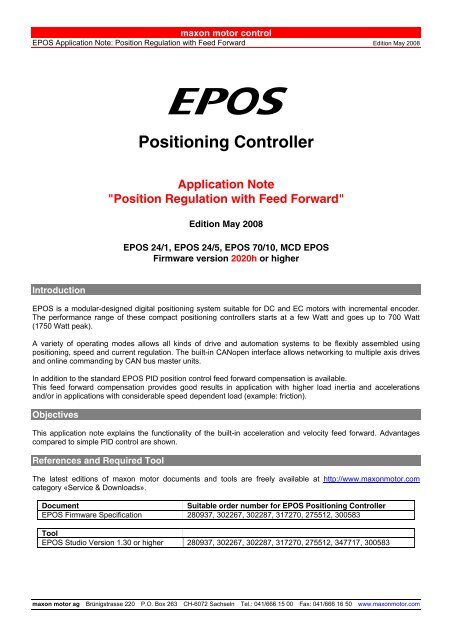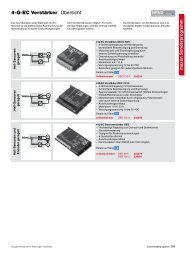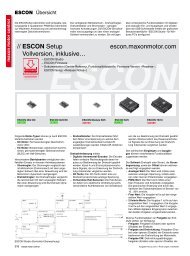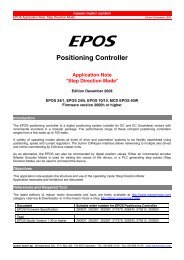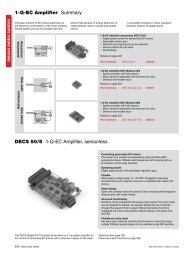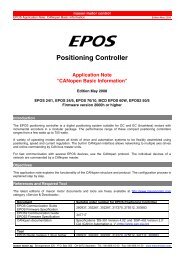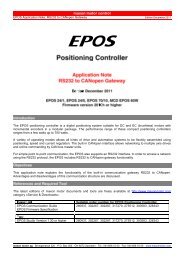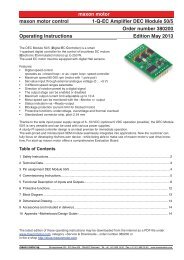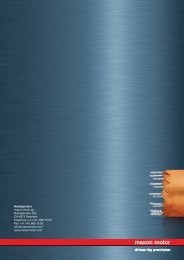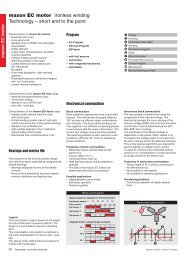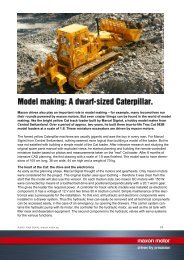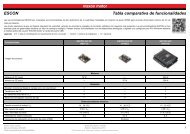Position Regulation with Feed Forward - Maxon Motor ag
Position Regulation with Feed Forward - Maxon Motor ag
Position Regulation with Feed Forward - Maxon Motor ag
You also want an ePaper? Increase the reach of your titles
YUMPU automatically turns print PDFs into web optimized ePapers that Google loves.
maxon motor control<br />
EPOS Application Note: <strong>Position</strong> <strong>Regulation</strong> <strong>with</strong> <strong>Feed</strong> <strong>Forward</strong> Edition May 2008<br />
<br />
<strong>Position</strong>ing Controller<br />
Application Note<br />
"<strong>Position</strong> <strong>Regulation</strong> <strong>with</strong> <strong>Feed</strong> <strong>Forward</strong>"<br />
Edition May 2008<br />
EPOS 24/1, EPOS 24/5, EPOS 70/10, MCD EPOS<br />
Firmware version 2020h or higher<br />
Introduction<br />
EPOS is a modular-designed digital positioning system suitable for DC and EC motors <strong>with</strong> incremental encoder.<br />
The performance range of these compact positioning controllers starts at a few Watt and goes up to 700 Watt<br />
(1750 Watt peak).<br />
A variety of operating modes allows all kinds of drive and automation systems to be flexibly assembled using<br />
positioning, speed and current regulation. The built-in CANopen interface allows networking to multiple axis drives<br />
and online commanding by CAN bus master units.<br />
In addition to the standard EPOS PID position control feed forward compensation is available.<br />
This feed forward compensation provides good results in application <strong>with</strong> higher load inertia and accelerations<br />
and/or in applications <strong>with</strong> considerable speed dependent load (example: friction).<br />
Objectives<br />
This application note explains the functionality of the built-in acceleration and velocity feed forward. Advant<strong>ag</strong>es<br />
compared to simple PID control are shown.<br />
References and Required Tool<br />
The latest editions of maxon motor documents and tools are freely available at http://www.maxonmotor.com<br />
category «Service & Downloads».<br />
Document<br />
Suitable order number for EPOS <strong>Position</strong>ing Controller<br />
EPOS Firmware Specification 280937, 302267, 302287, 317270, 275512, 300583<br />
Tool<br />
EPOS Studio Version 1.30 or higher 280937, 302267, 302287, 317270, 275512, 347717, 300583<br />
maxon motor <strong>ag</strong> Brünigstrasse 220 P.O. Box 263 CH-6072 Sachseln Tel.: 041/666 15 00 Fax: 041/666 16 50 www.maxonmotor.com
EPOS <strong>Position</strong>ing Controller<br />
maxon motor control<br />
EPOS Application Note: <strong>Position</strong> <strong>Regulation</strong> <strong>with</strong> <strong>Feed</strong> <strong>Forward</strong><br />
Controller architecture<br />
For the position control a discrete PID controller <strong>with</strong> anti windup, acceleration feed forward and velocity feed<br />
forward was implemented using a digital signal processor (DSP) where the sample time (T S ) was taken at 1ms,<br />
much smaller than the mechanical time constant of a typical drive system. The structure is shown in the following<br />
figure.<br />
Figure 1: Controller architecture<br />
Constants<br />
Constant EPOS 24/1 EPOS 24/5 EPOS 70/10<br />
k SP 2 5 = 32 2 3 = 8 2 2 = 4<br />
k SI 2 8 = 256 2 6 = 64 2 5 = 32<br />
k SD 2 2 = 4 2 0 = 1 2 0 = 1<br />
Encoder pulse number<br />
0 - 200 2 0 = 1<br />
201 - 1000 2 1 = 2<br />
1001 - 5000 2 2 = 4<br />
5001 - 7500 2 3 = 8<br />
k S<br />
2 maxon motor control Edition May 2008 / Subject to change
maxon motor control<br />
EPOS Application Note: <strong>Position</strong> <strong>Regulation</strong> <strong>with</strong> <strong>Feed</strong> <strong>Forward</strong><br />
EPOS <strong>Position</strong>ing Controller<br />
Object dictionary entries<br />
Units<br />
Symbol Name Index Sub-Index<br />
K P <strong>Position</strong> Regulator P-Gain 0x60FB 0x01<br />
K I <strong>Position</strong> Regulator I-Gain 0x60FB 0x02<br />
K D <strong>Position</strong> Regulator D-Gain 0x60FB 0x03<br />
K ω Velocity <strong>Feed</strong>forward Factor 0x60FB 0x04<br />
K α Acceleration <strong>Feed</strong>forward Factor 0x60FB 0x05<br />
Acceleration:<br />
Velocity:<br />
<strong>Position</strong>: [ ]<br />
Current: [ mA ]<br />
K P :<br />
K I :<br />
K D :<br />
K : α<br />
K : α<br />
K : ω<br />
Operation Modes<br />
⎡rad<br />
⎤<br />
⎢ 2<br />
⎣ s ⎥ ⎦<br />
⎡rad<br />
⎤<br />
⎢<br />
⎣ s ⎥ ⎦<br />
⎡ 1⋅<br />
( turn)<br />
⎤<br />
qc = ⎢<br />
⎥ (quadrature counts)<br />
⎣ Encoder _ pulse _ number ⋅ 4⎦<br />
⎡ mA ⎤<br />
⎢ ⎥<br />
⎣kSP<br />
⋅ kS<br />
⋅ qc ⎦<br />
⎡ mA ⎤<br />
⎢<br />
⎥<br />
⎣kSI<br />
⋅ kS<br />
⋅ qc ⋅TS<br />
⎦<br />
⎡ mA⋅T<br />
⎤<br />
S<br />
⎢ ⎥<br />
⎣kSD<br />
⋅ kS<br />
⋅ qc ⎦<br />
⎡ A −6 ⎤<br />
⎢<br />
⋅10<br />
2<br />
⎣rad<br />
/ s ⎥ ⎦<br />
⎡ A −7 ⎤<br />
⎢<br />
⋅10<br />
2<br />
⎣rad<br />
/ s ⎥ ⎦<br />
⎡ µ A ⎤<br />
⎢<br />
⎣rad<br />
/ s ⎥ ⎦<br />
(EPOS 24/5, EPOS 70/10 and MCD EPOS 60W)<br />
(EPOS 24/1)<br />
(EPOS 24/1, EPOS 24/5, EPOS 70/10 and MCD EPOS 60W)<br />
The acceleration and velocity feed forward take effect in Profile <strong>Position</strong> Mode and Homing Mode. There is no<br />
influence to all the other operation modes like <strong>Position</strong> Mode, Profile Velocity Mode, Velocity Mode and Current<br />
Mode.<br />
Purpose of K (Acceleration <strong>Feed</strong>forward Factor)<br />
α<br />
K provides additional current in cases of high acceleration and/or high load inertias.<br />
α<br />
Purpose of K (Velocity <strong>Feed</strong>forward Factor)<br />
ω<br />
K provides additional current in cases, where the load increases <strong>with</strong> speed, e.g. speed dependent friction. The<br />
ω<br />
load is assumed to increase linear <strong>with</strong> speed.<br />
Edition May 2008 / Subject to change maxon motor control 3
EPOS <strong>Position</strong>ing Controller<br />
maxon motor control<br />
EPOS Application Note: <strong>Position</strong> <strong>Regulation</strong> <strong>with</strong> <strong>Feed</strong> <strong>Forward</strong><br />
<strong>Regulation</strong> Tuning<br />
<strong>Regulation</strong> tuning is a sophisticated process for most drive systems. maxon motor EPOS Studio includes a<br />
powerful wizard called <strong>Regulation</strong> Tuning. By means of this <strong>Regulation</strong> Tuning wizard most systems can be well<br />
tuned <strong>with</strong>in a few minutes. To tune an EPOS drive system follow these steps:<br />
Step 1: <strong>Motor</strong> and system specific settings<br />
Execute the Startup Wizard. It can be found via the navigation window Wizards of the EPOS Studio.<br />
Figure 2: Startup-Wizard<br />
Step 2: Current regulator tuning<br />
Execute the regulation tuning by executing the regulation tuning wizard and follow the instructions to tune the<br />
current regulator. Do not tune the position regulator nor the velocity regulator at this moment.<br />
Figure 3: <strong>Regulation</strong> Tuning<br />
Step 3a: Calculation of acceleration feed forward factor<br />
Calculate the acceleration feed forward factor K as follows:<br />
α<br />
k<br />
J<br />
K α =<br />
tot<br />
⋅100<br />
k<br />
m<br />
J<br />
K α =<br />
tot<br />
⋅1000<br />
k<br />
m<br />
[EPOS 24/5, EPOS 70/10 and MCD EPOS 60W]<br />
[EPOS 24/1]<br />
- [ mNm / A ] is the motor torque constant (maxon motor catalogue line 12)<br />
m<br />
J tot<br />
gcm<br />
2<br />
- [ ] is the total inertia of the drive system. If the total inertia is not known take twice the rotor inertia<br />
(maxon catalogue line 16) and check position regulation. Increase<br />
J tot<br />
in the upper formula if necessary.<br />
2<br />
J = J + J [ ]<br />
tot<br />
motor<br />
load<br />
gcm<br />
Step 3b: Write the new acceleration feed forward factor<br />
Write the calculated value of K α to the object Acceleration <strong>Feed</strong>forward Factor (go to Object Dictionary):<br />
K α Acceleration <strong>Feed</strong>forward Factor 0x60FB 0x05<br />
4 maxon motor control Edition May 2008 / Subject to change
maxon motor control<br />
EPOS Application Note: <strong>Position</strong> <strong>Regulation</strong> <strong>with</strong> <strong>Feed</strong> <strong>Forward</strong><br />
EPOS <strong>Position</strong>ing Controller<br />
Step 4a: Calculation of Velocity<strong>Feed</strong>forward Factor<br />
Calculate the Velocity <strong>Feed</strong>forward Factor K as follows<br />
ω<br />
K<br />
ω<br />
30 ∆I<br />
= ⋅<br />
π ∆ω<br />
[µA /rad /s]<br />
K<br />
- ω [µA /rad /s] considers a linear load current increase<br />
∆ ω [rpm]<br />
∆ I [µA] if the angular velocity is enhanced by<br />
-<br />
∆I<br />
∆ω<br />
can easily be determined by measuring the current at two different speeds. (You can also assume<br />
I=0 at ω =0).<br />
Step 4b: Write the new velocity feed forward factor<br />
Write the calculated value of K ω to the object Velocity <strong>Feed</strong>forward Factor (go to Object Dictionary):<br />
K ω Velocity <strong>Feed</strong>forward Factor 0x60FB 0x04<br />
Step 5: <strong>Regulation</strong> tuning<br />
Now the system is prepared for the position regulation tuning <strong>with</strong> the <strong>Regulation</strong> Tuning Wizard. See Getting<br />
Started document for a step by step instruction.<br />
Edition May 2008 / Subject to change maxon motor control 5
EPOS <strong>Position</strong>ing Controller<br />
maxon motor control<br />
EPOS Application Note: <strong>Position</strong> <strong>Regulation</strong> <strong>with</strong> <strong>Feed</strong> <strong>Forward</strong><br />
Example<br />
As an example a maxon motor EC40 was used:<br />
<strong>Motor</strong> (#118899)<br />
No load velocity (line 3)<br />
3100 rpm<br />
No load current (line 6)<br />
41 mA<br />
Torque constant (line 12)<br />
145 mNm/A<br />
Rotor inertia (line 15) 85 gcm 2<br />
The mechanical load was given <strong>with</strong> four brass discs, each <strong>with</strong> 740 gcm 2 inertia:<br />
Mechanical load<br />
Load inertia 2960 gcm 2<br />
With the given load conditions the motor inertia to load inertia rate is 1 : 35. Therefore the system is not easy to<br />
control.<br />
The following measurements have been made <strong>with</strong> the built-in data recorder of the tool EPOS Studio. To start the<br />
data recorder select the recorder tab:<br />
Figure 4: Data recorder configuration<br />
6 maxon motor control Edition May 2008 / Subject to change
maxon motor control<br />
EPOS Application Note: <strong>Position</strong> <strong>Regulation</strong> <strong>with</strong> <strong>Feed</strong> <strong>Forward</strong><br />
EPOS <strong>Position</strong>ing Controller<br />
The following graph results <strong>with</strong>out feed forward after auto tuning:<br />
Figure 5: Recorded profile <strong>with</strong> stiff PID control<br />
<strong>Position</strong> Regulator P-Gain 1895<br />
<strong>Position</strong> Regulator I-Gain 76<br />
<strong>Position</strong> Regulator D-Gain 16500<br />
Velocity <strong>Feed</strong>forward Factor 0<br />
Acceleration <strong>Feed</strong>forward Factor 0<br />
Maximal <strong>Position</strong> Error<br />
96qc<br />
The following graph results <strong>with</strong> calculated feed forward parameters after auto tuning:<br />
Figure 6: Recorded profile <strong>with</strong> feed forward and smooth PID control<br />
<strong>Position</strong> Regulator P-Gain 1500<br />
<strong>Position</strong> Regulator I-Gain 40<br />
<strong>Position</strong> Regulator D-Gain 1505<br />
Velocity <strong>Feed</strong>forward Factor 132<br />
Acceleration <strong>Feed</strong>forward Factor 2100<br />
Maximal <strong>Position</strong> Error<br />
35 qc<br />
Conclusion<br />
In practice direct drive systems often are used as a result of lower system costs and requirements for a backlash<br />
free system. Therefore ratio between motor inertia and load inertia often are 1:10 or higher.<br />
The EPOS motion controller uses traditional PID control and <strong>with</strong> firmware version 2020h or higher there is a<br />
acceleration feed forward and velocity feed forward implemented. With this controller architecture it is possible to<br />
smoothly control systems <strong>with</strong> high ratio between motor and load inertia.<br />
Edition May 2008 / Subject to change maxon motor control 7


